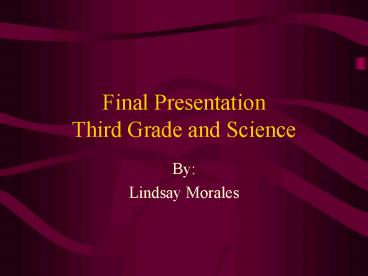Final Presentation Third Grade and Science PowerPoint PPT Presentation
1 / 18
Title: Final Presentation Third Grade and Science
1
Final PresentationThird Grade and Science
- By
- Lindsay Morales
2
Background Information School Weemes (Lenicia
B.) Elementary2000-2001 Class Size
3
Background InformationTechnology
- Number
- Computers 274
- Students per Computer 6.0
- Classrooms with Internet 1
4
Background InformationStudents
- Third Grade
- Ages 8- 9
- Number of Students 24
- Subject Science
- Lesson
5
Content Standards3rd Grade Life Science
- Students know examples of diverse life forms in
different environments, such as oceans, deserts,
tundra, forests, grasslands, and wetlands. - Students know living things cause changes in the
environment in which they live some of these
changes are detrimental to the organism or other
organisms, and some are beneficial.
6
Lesson OneStudy of plant life in different
Environments
- Lesson Objective
- Students will explore different types of
eco-systems to determine what kind of plant life
lives there. - Motivation
- Show students a short video from the Discovery
Channel on different types of eco-systems.
7
Lesson One Study of plant life in different
Environments
- Learning Procedure
- Brief Discussion of video and different kinds of
eco-systems. - Review of the different forms of plant life.
- Students are put into groups of 4 and are
assigned an eco-system to explore. - In a few sentences, students will describe the
kind of eco-system assigned to them and give
two-three different types of plants that survive
there.
8
Lesson One Study of plant life in different
Environments
- Feedback/Assessment
- Each group of students is required to draw a
picture of the assigned eco-system and the types
of plants that live there. - Upon finishing the picture a short presentation
of the picture will take place with every member
of the group contributing.
9
Lesson Two Study of animal life in different
Environments
- Lesson Objective
- Students will explore different types of
eco-systems to determine what kind of animals
live there. - Motivation
- Pictures of different types of animals will be
passed around the classroom so that each student
can take a few minutes to look at each animal.
10
Lesson Two Study of animal life in different
Environments
- Learning Procedure
- Brief review of the eco-systems and plants
studied the day before. - Review of the knowledge about animals the
students already know about. - Students return to the groups of four assigned
the day before and explore what types of animals
live in the eco-system previously assigned. - In a few sentences, students provide two-three
animals that live in the eco-system and one-two
characteristics of the animal (e.g. carnivore,
herbivore etc.).
11
Lesson Two Study of animal life in different
Environments
- Feedback/Assessment
- Students will add the animals into the picture of
the eco-system drawn the previous day. - Students will give another short presentation
reviewing which eco-system each group was
assigned, the types of plants that are found
there, and the addition of the types of animals
that live there along with a few characteristics
of the animals. - Every group member will contribute.
12
Lesson ThreeThe Food Chain
- Lesson Objective
- Students will explore different food chains that
animals are a part of and the effects each food
chain has on the environment. - Motivation
- Ask each student what is their favorite kind of
food and what is their least favorite kind of
food.
13
Lesson ThreeThe Food Chain
- Learning Procedure
- Brief lecture about different kinds of animals in
terms of carnivores, herbivores, and omnivores. - Review of what the students already know of the
subject. - In the same groups of four, students are assigned
to research the animals chosen the day before to
find out what type of animal it classifies as
(e.g. carnivore, herbivore, omnivore). - In a few sentences tell what the animal is
classified and what it eats as well as predict
what might happen if what the animal eats no
longer exists.
14
Lesson ThreeThe Food Chain
- Feedback/Assessment
- Students will add the things that each animal
eats to the picture drawn the previous days if it
is not already on the picture. - Students will give another, longer, final
presentation on what they learned about the
eco-systems, the plants, the animals, and what
each animal eats. - Every member must contribute.
15
Technology
- Television/Video
- Show students footage of different eco-systems.
- Computers/Internet to research the eco-systems.
16
Assessing Student Learning
- Presentations of the material learned in class.
- Students could write a short paragraph about what
they learned during the lesson as a final report. - Objective Testing
17
Blackboard Discussion Board
- In progress
18
References
- California State Board of Education, Academic
Standards - http//www.cde.ca.gov/board/
- Ed-Data Website
- http//www.ed-data.k12.ca.us/
- Pro-Teacher sample lesson plans
- http//www.proteacher.com/110003.shtml

